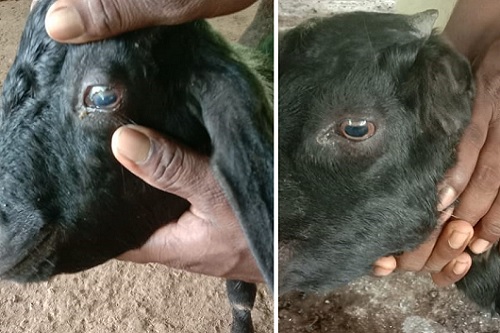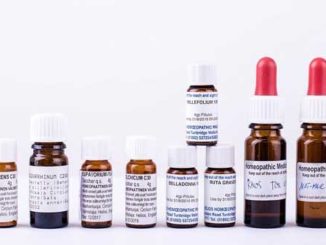Goats constitute an important livestock activity in A & N Islands. The goats available in these Islands are of mainly meat type and there is high demand for chevon in these islands. They are important productive asset of landless, marginal, and small landholders of these islands and it generates a flow of income and employment throughout the year for the resource less farmers residing in remote locations of these Islands. In the present case report, eye infection in goat was reported and treated successfully with herbal based eye drop.
History
A farmer from South Andaman has a flock of 45 goats. Goats were kept under semi intensive system and all goats had been done deworming. Few adult goats showed eye infection with purulent discharge.
Clinical Examination
Clinical signs revealed that the goats were dull and depressed. The goats were pyrexic (40°C). Examination of both eyes revealed conjunctivitis and purulent discharges (Figure 1) from one eye. There was no nasal discharge.
Diagnosis
Based on the clinical signs of pyrexia and purulent ocular discharges, the case was tentatively diagnosed as pink eye (conjunctivitis).

Herbal treatment
The extract was prepared out of dried and powdered leaves of Glycosmis pentaphylla and Spondias pinnata using coconut and sesame oil as carrier at appropriate proportions and filtered hygienically to get clear drops extract. The prepared drops are known to be safe and non-irritating to conjunctiva as both the oils have smoothening effect. It was advised to wash the affected eyes with aqueous extract prepared out of neem leaves. Subsequently, this oil based herbal eye drop was applied twice a day till the infection was cleared. On day 9, the affected eyes were devoid of purulent discharges and eye sight was clear. These plants are rich in flavonoids and phenols. This herbal treatment to cure eye infections could be accomplished through synergistic effect with content of arborine and skimmianine in Glycosmis pentaphylla and Sitosterols in Spondias pinnata.

Treatment of pinkeye includes washing the eye with sterile saline and then application of antibiotic drops or ointment, such as Terramycin eye ointment, several times a day until after the eye is improved. In this line of treatment, animals are sensitive to the chemically synthesized antibiotics in turn may cause sub-conjunctival swelling and pain.
Herbal treatment as reported in the present case report has less side-effects and toxicity as compared to chemical therapeutics. Therefore, thistype of herbal treatments for eye infection has to be initiated in livestock. This case study throws light on the veterinary and medical chemists and professionals to proceed forward for herbal compounds for eye treatment without side effects, toxicity and allergic reactions.
| The content of the articles are accurate and true to the best of the author’s knowledge. It is not meant to substitute for diagnosis, prognosis, treatment, prescription, or formal and individualized advice from a veterinary medical professional. Animals exhibiting signs and symptoms of distress should be seen by a veterinarian immediately. |
How useful was this post?
Click on a star to review this post!
Average Rating 4.5 ⭐ (53 Review)
No review so far! Be the first to review this post.
We are sorry that this post was not useful for you !
Let us improve this post !
Tell us how we can improve this post?
Authors
-

Senior Scientist, Animal Science Division, ICAR-Central Island Agricultural Research Institute, Port Blair, Andaman and Nicobar Islands, India
-

Principal Scientist, Animal Science Division, ICAR-Central Island Agricultural Research Institute, Port Blair, Andaman and Nicobar Islands, India
-

Principal Scientist, Division of Animal Science, ICAR-Central Island Agricultural Research Institute, Port Blair, Andaman and Nicobar Islands
-

Scientist, Division of Animal Science, ICAR-Central Island Agricultural Research Institute, Port Blair, Andaman and Nicobar Islands





Be the first to comment